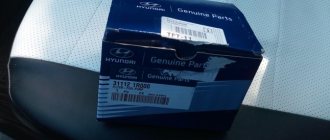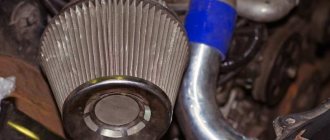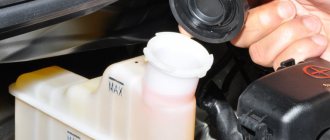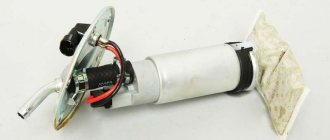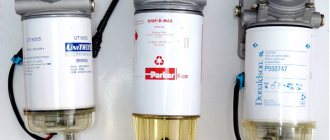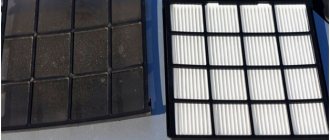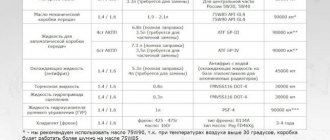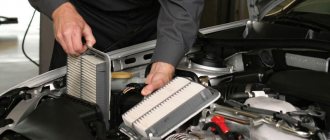Fuel filter replacement process
If you have enough experience, the procedure can be performed in a garage using basic tools. Before you begin, you should find out where the fuel filter is located on the Hyundai Solaris. The location of the module is inside the fuel tank. In order to begin dismantling, you must purchase an original spare part according to the catalog number.
After this, you can begin to remove and disassemble, but first you need to remove the filter from the fuel tank.
Remove the rear sofa by pulling it towards you. First, use a socket wrench to unscrew the 12 nut located between the back and the back of the seat. The plastic protection, located on the left side of the bottom of the car, is secured with a special sealant. To dismantle it, you need to gently heat the contact area that runs along the perimeter with a hair dryer. Treat the surface with a special spray, since a large amount of dust always accumulates between the tank and the outer part of the body. It is necessary to prevent dirt from getting inside the tank. After unscrewing the three bolts, remove the ring holding the fuel filter module. Disconnect the electrical connector. Disconnect the two fuel lines. Prepare a gasoline container in which you can place the fuel module. Drain the remaining fuel and sit comfortably in a bright place. In order to disassemble the fuel filter, the only tool you need is a flat-head screwdriver. Disconnect the fuel lines leading from the cover to the filter element by pulling out the retaining metal clips. Pry up the plastic clips that hold the two metal pins in place. The length of the wires is sufficient to then disconnect the electrical connector from the fuel pump located inside the fuel module. Bend the three plastic tabs and disconnect the assembly that houses the fuel pump and filter. Before changing the fuel filter on Solaris, carefully examine the new part. By comparing it with the old unit, you will intuitively understand which elements and in what sequence need to be removed from the old one and installed on the new one. From the inside, spread the two plastic tabs and pull out the fuel pump. Using a flat-head screwdriver, remove the coarse filter by pulling it off the axis on which it is attached
It is important not to lose the rubber seals. Leave them on the old parts, and during assembly, install each one on a new filter and only then mount the assembly. Start the assembly by installing a new coarse filter, which comes with the new filter. Install the fuel pump into the new filter by snapping it into place with the plastic clips. Transfer all parts from the old filter to the new one.
The developers provide for disassembling and installing a new filter and fuel pump. Therefore, all elements are secured with latches. When dismantling (installing), proceed delicately
Pay special attention to the installation of fuel pipes and rubber seals to prevent loss of pressure in the fuel rail
Install the fuel module into the vehicle tank in the reverse order, being careful not to mix up the fuel supply and return lines.
Don't rush to start the engine. Turn the key in the ignition switch several times, filling the volume of the fuel module. You can tell by the sound whether it is filled with gasoline. After the sound has become monotonous, you can start the car.
Avoid unstable operation of the fuel pump; change it at the first sign of a malfunction or after a mileage of 60 thousand kilometers (after 3 years of car operation). The time when changing the fuel filter may be lost, then you will need to replace a more expensive part - the fuel pump.
If the material was interesting or useful for you, publish it on your social network page:
Hyundai Solaris Silver Shark › Logbook › Replacing the fuel filter
Well, it's done.
Almost 5 years after leaving the dealership and having run nearly 116,000 km, I finally decided to replace the fuel filter myself and have never regretted it. So to speak, I upgraded my experience (“experience” in Russian speaking). I ordered fuel through autodoc: 1: original fuel filter 311121R000. After talking with people, I realized that I made a little mistake with the choice - I could have taken a “2nd line” filter, it would have been cheaper. 2. coarse fuel filter (mesh) original 311841R000. I also spent too much - I could have bought a non-original one much cheaper. And some people don’t bother at all - they wash it out. that was. I decided to replace. But in order.
So. The fuel filter is located under the seat of the rear sofa, which is mounted on two clamps under the side passengers and in the center in the backrest with a “12” bolt. Under the seat we see a black cover.
I read so much, and it’s written in the “Murzilka”. which is easy to remove. Fuck there. My lid was sitting on black sealant. But by slightly prying it with a flat screwdriver, the lid gave way.
What I saw next is something I haven’t seen in anyone, including in Murzilka.
So everything was covered in a thick layer of dust (no wonder, after all, no one had climbed there in 5 years). I thought this compartment would be sealed. But no, at the bottom I saw a hole underneath the bottom. I wiped off the entire fuel module cover so that no harm would disturb the virgin world of the gas tank.
Before disconnecting the fuel line hoses, it is necessary to release the pressure in the system. To do this, I removed the negative terminal from the battery using the Murzilka. Then I disconnected the fuel module power supply. Now you need to start the engine. When you turn the key for the first time, in test mode, the empty tank indicator on the dashboard starts blinking (this is understandable, because the sensor is disconnected). He didn’t grab the engine right away—he was coughing and choking, but he tried to turn it. At this time, for some reason the oil pressure indicator began blinking on the instrument panel. At first I didn’t understand that everything was done as it should. I started it a second time - the setting was better, but after a couple of seconds the engine stalled - the fuel ran out... In theory... But when one of the hoses was disconnected, it turned out to be nothing. It's not much, but it's not pleasant to be doused with gasoline. Fortunately, after replacing the filter, I planned to clean up the PCB in the cabin. Having disconnected two hoses (one is simply put on the fitting, the other through a special clamp) and removing the third hose from the mount (I did not disconnect it), we unscrew the 8 bolts around the perimeter. I used a large Phillips screwdriver. Before unscrewing the last bolt, we hold the fuel module - its upper part is on springs, which push the structure upward. Having removed the fixing ring, we take out the module. Here you have to be a little clever so as not to tear off the float. And yes, there is another 200 grams of fuel in the bowl, so when we pull it out, we don’t tilt it too much. And voila, the structure is outside
And we begin to remove from it everything that we need. And we will need everything except the old filter.
Just in case, I photographed the position of the module's power terminals so that during assembly I wouldn't confuse which was which. Having disconnected the terminals, remove the upper part, which is springy. To do this, there are clamps at the bottom of the rods, which should be slightly bent and the structure pulled up.
We remove the hoses, for which you need to pull out the bracket on each hose. We don't lose staples.
We disconnect the latches (4 pieces) that secure the filter and pump to the bowl. And take out the filter itself and the pump, which hangs on the filter with latches. . This is the sediment in the bowl
Next we continue to disassemble. We do not remove the hose from the pump. The hose will move along with the pump. From the old filter we will also need to remove the fuel pressure regulator with a retainer, which sit on latches
This is where you need to be as careful as possible. so as not to lose the o-rings. There will be 3 of them - one will be in the lock on the front of the regulator, one will be on the regulator, for a tight fit to the body, and the third - the smallest one will most likely remain in the body of the regulator compartment on the old filter
We remove the coarse filter from the bottom of the pump by prying it with a screwdriver in the area of the retaining washer in the filter housing.
Hyundai Solaris fuel filter
Since 2001, the vast majority of foreign cars have been equipped with an internal coarse fuel filter (hereinafter referred to as PF). External filters are no longer practiced as mandatory standard equipment.
At the same time, such an innovation is both good and bad, since the quality of fuel absorption decreases and the frequency of technical inspection of the machine increases.
TF cleans fuel from all kinds of impurities, debris, and condensation. Contaminated fuel does not burn completely, which contributes to the formation of soot.
Systematic operation of a car with low-quality fuel leads to increased acceleration time, increased gasoline consumption, and unstable operation of the power unit.
Where is the TF located: in the center of the channel under the rear passenger seat. Access for maintenance from inside the car; first remove the diagnostic hatch.
If necessary, replacing the TF on your own is not at all difficult; no special skills are required. If you do not practice independent repairs, then seek help from service center specialists.
Where is the fuel filter located on the Hyundai Solaris?
Every car enthusiast periodically faces the need to repair and maintain his car. Elimination of most faults and carrying out routine maintenance is most often carried out at service stations. In addition, if the machine is purchased new, it has a warranty period, during which everything necessary is carried out at authorized service centers. However, the need for repairs or maintenance by the owner himself arises with enviable regularity. For example, replacing the fuel filter on a Hyundai Solaris. This part is essentially considered a consumable item. However, its service life is considerable. And some motorists generally drive without making replacements and do not complain about engine performance.
Causes of clogging
- unstable start of the power unit at different temperature conditions;
- increased fuel consumption, including under load;
- engine detonation at idle speed;
- acceleration is slower than usual;
- lumbago in the exhaust pipe;
- the car engine chokes as a result of an enriched or lean combustible mixture;
- The “Check Engine” light on the instrument panel is on.
- operating the vehicle for longer than the recommended period before undergoing a scheduled technical inspection;
- refueling with low-quality fuel, low-octane mixture for a long time;
- installation of non-original consumables;
- installation of spare parts from other technical equipment that are similar in appearance to factory ones;
- the machine was left idle for a long time, in the “preservation” mode, as a result of which the circuit became clogged and sediment formed.
Which fuel filter is best for Solaris
The manufacturer insists that we use only original fuel filters. They have the following catalog numbers, fine filter:
- fine filter Hyundai/Kia 311121R000, price about 400-450 hryvnia;
- a non-original NIPPARTS filter with catalog number N1330330 costs 320 hryvnia;
- filter ASHIKA, Italy, article 300KK21, price 434 hryvnia, very good quality;
- English BLUE PRINT, article ADG02404, costs 480 hryvnia;
- Korean brand NSP, catalog number NSP02311121R000, price 220 hryvnia.
Coarse filter, mesh:
- original Hyundai/Kia filter 311841R000 costs 170-200 hryvnia;
- Korean filter KROSS, KM7901114, price 70 hryvnia;
- MOBIS, number 311841R000, in fact, this is a conveyor filter, but in the company’s packaging it costs no less than 270 hryvnia.
Choosing a fuel filter for Hyundai Solaris
The original filter has article number 31112-1R000. Since it is installed on a large number of Hyundai and Kia models, it is not difficult to find in stock, and its price is low - about 900 rubles. Buying a non-original product will not bring significant savings, but may result in worse fuel filtration.
Therefore, not all analogues can be recommended - among high-quality substitutes, it is worth mentioning Finwhale PF731, Blue Print ADG02404, AMC Filters KF1473.
Access to the fuel module
Before starting work, it is necessary to remove the pressure from the fuel line and dry it, as it will be necessary to disconnect the hoses from the fuel block. There are two ways to do this. The first method is simple
, when the engine is turned on, the fuse that is in the power supply circuit of the pump and level sensor is removed from the fuse box. The pump stops pumping fuel and after a couple of minutes the engine stalls. After this, you need to make a couple of turns with the starter and the pressure in the line will be released.
Another method differs in the method of disconnecting power from the module
. To do this, we begin to disassemble the rear seat. The fastening bolt can be reached through the gap between the seat and the backrest. It is unscrewed by an extension with a 12-point cap. After this, the cushion holders are removed and it is removed from the cabin, freeing up space for work.
Next manipulation
. It is necessary to use a sharp knife to make a cut in the sealant that covers the fuel unit hatch that needs to be opened. Access to the module and plug connector for power supply and signal transmission from the sensor is provided. Now, in order not to look for a fuse for the fuel system, simply pull the plug out of the socket with the engine turned on and repeat the procedure for relieving pressure described above.
{banner_content}
Hyundai Solaris Manual
We carry out the work to clean the strainer, replace the fine fuel filter, fuel level indicator sensor, fuel pump or fuel module assembly.
Shown is work on a sedan car. Using a 12mm socket with an extension, unscrew the rear mounting bolt for the rear seat cushion.
Access to the bolt through the gap between the cushion and the back of the rear seat.
Lifting the front part of the pillow, we remove the two brackets for its front fastening from the holders...
...and remove the rear seat cushion.
Using a knife, we cut the sealant around the perimeter of the fuel module hatch cover...
...and remove the hatch cover. With the ignition off, squeeze the clamps of the wiring harness block...
...and disconnect the block from the fuel module cover connector. If shortly before starting operations to dismantle the fuel module, the ignition was turned on, then it is necessary to relieve the fuel pressure in the power system. To do this, we start the engine and, if it starts, let it idle until it stops due to the exhaustion of fuel in the system. Then turn on the starter for 2-3 seconds. After this, the fuel pressure in the power system will be relieved.
Using pliers, squeezing the ends of the clamp securing the fuel vapor supply hose to the adsorber, slide the clamp along the hose...
...and remove the hose from the fitting of the fuel module cover. By pressing the clamps of the tip of the fuel supply tube to the ramp...
...remove the tip from the fitting of the module cover.
We remove the holder of the fuel vapor supply tube to the canister purge solenoid valve from the hole in the module cover bracket.
Using the “8” head, unscrew the eight bolts securing the pressure plate of the module cover...
...and remove the plate.
Carefully, so as not to get caught in the float of the fuel level indicator sensor, remove the fuel module from the opening of the fuel tank.
We take out the rubber O-ring sealing the connection between the module cover and the flange of the tank opening.
By pressing the lock of the fuel level sensor wire block, disconnect the block from the module cover connector. We remove the fuel level sensor wires from the holders on the cover...
...and a glass of the fuel module.
Using a flat screwdriver, pry the fuel gauge sensor retainer...
...move the sensor along the guides of the module cup...
...and remove the sensor with wires. By pressing the lock of the fuel pump wire block...
...disconnect the block from the fuel module cover connector.
Use a screwdriver to pry the spring clamp of the tip of the fuel supply tube from the filter to the module cover...
Remove the tip of the tube from the outlet fitting of the fuel filter and take out the sealing rubber ring.
Similarly, remove the tip of the fuel pump tube from the filter inlet fitting.
Using a flat screwdriver, press the clamps of the two guide rods of the fuel module cover onto the cup body...
...separate the lid and the fuel module glass. Disconnect the wiring harness from the fuel pump.
Using a flat screwdriver, pry up the two latches on the housing of the module cup...
...we remove the fuel filter assembly from the glass with a pump, strainer and fuel pressure regulator.
In the hole in the bottom of the fuel module cup there is a rubber valve that prevents fuel from leaking out of the cup.
Using a screwdriver, loosen the two latches...
...remove the fuel pump with the tube from the socket in the filter housing.
Using a flat screwdriver, pry off the lock washer...
...remove the strainer from the pump nozzle.
Remove the lock washer from the slot in the strainer housing.
To remove the plastic corrugated tube from the pump nozzle, you can pour hot water on it.
Remove the rubber o-ring from the tip of the fuel drain tube and disconnect the tip of the “mass” wire from the outlet of the fuel filter housing.
Using a flat screwdriver, pry off the two lugs of the fuel pressure regulator clamp and the fuel drain pipe...
We remove the fuel pressure regulator from the socket of the fuel filter housing. Remove the fuel pressure regulator from the flange...
...rubber sealing ring...
...and a plastic retaining ring.
Disconnect the fuel drain pipe from the fuel filter housing.
Using a screwdriver, remove the rubber sealing ring of the tip of the fuel pressure regulator from the socket of the fuel filter housing.
Fuel filter with O-rings on the inlet and outlet fittings.
In the socket of the fuel drain tube there is a rubber sealing ring for the tip of the fuel filter housing. To replace the valve located in the fuel drain pipe, press the locking lugs...
...and remove the valve retainer.
We take out the spring with the rubber valve washer. To replace the gravity valve of the fuel vapor recovery system located in the fuel module cover...
...use a flat screwdriver to press out the two fasteners...
...and remove the valve from the module cover socket.
Step by step replacement
1. Remove the rear seat. Unscrew the twelve bolt in the center of the seat.
To find the bolt, you need to squeeze the seat cushion a little.
2. Warm up the sealant on the fuel pump cover with a hairdryer. Once warmed up, remove the lid.
3. Disconnect the connector shown below and remove the cover to the side
Please note that to disconnect the connector you need to squeeze the ears on the sides
4. We take out the fuel line indicated below and put it aside; we don’t need it.
5. Remove the fuel supply and return pipes.
6. Unscrew the bolts securing the fuel pump pressure washer. Bolts for a Phillips screwdriver.
7. We take out the fuel module and carefully place it in a container so as not to stain the body with gasoline.
8. Using a flathead screwdriver, remove the two metal brackets marked below.
9. Use a screwdriver to pry up the two latches and remove the upper part of the fuel module.
10. Remove the fuel pump power plug.
11. Pry the three plastic tabs with your fingers and pull out the fuel pump with filter.
12. Disconnect the ground wire.
13. Pry up the two plastic tabs securing the fuel pump and remove it.
14. Use a flat screwdriver to pry up the fuel pump mesh filter fastener and remove it.
15. Next you need to install a new mesh filter and assemble everything with the new filter. I won’t describe the assembly process, all the information is in the video tutorial.
Is it possible not to change at all?
Opinions differ among car owners about how often the fuel filter needs to be changed. While some reduce the interval between purchasing a new part, others calmly drive hundreds of thousands of kilometers without complaining about anything. However, sooner or later the clogging of the elements will make itself felt.
There are a lot of components and assemblies in a car, and given a certain kind of behavior of the car, it is quite difficult to calculate where exactly the fault lies. When the car has trouble starting or stalls suddenly when switching to neutral (and this could be right in the middle of the street), the first thing to blame is a clogged fuel filter.
A critical drop in the car's acceleration performance indicates that the engine is unable to pull with increased fuel consumption. You'll have to crawl under the back seat. And although critical breakdowns should not occur if routine replacement is ignored, the fuel pump itself will sooner or later fail.
When to change the filter?
If the Hyundai Solaris was purchased from a car dealer, then according to technical regulations the filter element is replaced every two years or every 60 thousand mileage. But the “freshness” of the car does not guarantee that everything will go according to the regulatory scheme. Low-quality gasoline can cause contamination of the filtration system ahead of schedule.
Signs of a clogged filter element:
- traffic dynamics have decreased;
- there were shocks while driving;
- The engine took a long time to start.
Replacement process
When carrying out the procedure for replacing the filter element in a Hyundai Creta, you need to arm yourself with: pliers, a Phillips and flat-head screwdriver, a tube of sealant and a 12mm socket.
Fuel filter replacement procedure:
To remove the rear row of seats, you need to unscrew the two mounting bolts with a 12mm socket. After this, remove the protective plastic casing. It is worth remembering that it is fixed to the sealant, so to avoid its deformation, pry it off with a screwdriver. Now a hatch with four screws has “opened” in front of you. Now you need to reduce the pressure in the system. To do this, start the engine and disconnect the clamp from the fuel pump power connector. After wiping or vacuuming the cover from dirt and sand, we safely disconnect the fuel hoses. First, remove both fuel supply hoses; you will need pliers for this. Squeeze the locking latches and remove the hose.
Remember that it will most likely leak the remaining gasoline in the system. Unscrew the fuel pump fasteners. After this, remove the ring and very carefully pull the filter itself out of the housing. Try not to spill the remaining fuel in the filter and do not forget to fix the position of the float that determines the fuel level. Using a flathead screwdriver, pry up the metal clips and remove both tubes, then remove the two connectors. Carefully move the plastic latch to the side to release the guides. This step will help you get them out along with the lid. You can remove the filter element, together with the pump, from the glass only by holding the plastic latches. Disconnect the wire from the negative channel
Insert a screwdriver between the motor latches and the filter ring to remove it. After these steps, all that remains is to remove the metal valve. Then remove all o-rings from the old filter, check their integrity and install the valve on the new filter. To remove the plastic part you will have to loosen the latches; the next step is to install the O-rings on the new filter. At this point you can begin the assembly process. To begin, install the motor back on the filter and hook both fuel hoses with metal clips. After installing the motor, install the filter back into the housing; it will fit there only in the only correct position. We install the hatch with guides, tighten the fastening bolts and connect the power column in place. The pump is now fully assembled and can be placed back into the fuel tank. Coat the contour of the edge of the protective cover with sealant and put it in place. Product selection
Cleaning old or replacing
The fuel filter is a disposable part that belongs to the category of consumables. Its design has a porous membrane that traps debris, resins, and paraffin. It is impossible to wash it. Moreover, the filter housing is non-separable, so trying to clean it and put it back will result in a headache.
But the coarse filter mesh, which is located at the outlet of the gas tank, can be washed - preferably in acetone, and then blown with a stream of air from the compressor.
How long does it take to change the fuel filter on a Solaris?
Replacing the fuel filter Hyundai Solaris
Complexity:
Regular car maintenance is mandatory. The manufacturer has developed special rules for diagnosing (replacing) main parts. Waypoints are focused on the mileage or lifespan of the vehicle.
Most of the operations listed here can be done without the help of others. This also applies to procedures such as replacing the fuel filter on Solaris
. The introduction of high quality fuels, which must comply with the European standard EN228, is essential. If the discrepancy persists, special additives recommended by Hyundai should be used.
when is the filter changed
For the first time, it is necessary to note the element that cleans the fuel when the car has run 30,000 km or after two years of operation. A diagnosis will be helpful. Its essence is to measure the pressure in the fuel rail using a special device.
If it is not suitable for replacement, the next major problem will be the failure of the fuel pump
. This sometimes happens unexpectedly. The corresponding part may not be displayed nearby.
If the fuel system pressure is not assessed, the main reason for this will be more clogging. fuel filter
.
In such conditions, replacement is recommended.
Hyundai Solaris fuel filter
How long does it take to change the VAZ 2110 fuel filter?
Fuel filter replacement process
If you are experienced enough, the function can be performed in the garage using a simple tool. Before you begin, you need to find out where the fuel filter is located on the Hyundai Solaris. The location of the module is inside the fuel tank. To start disassembling, you need to purchase an unusual spare part by catalog number.
replacing fuel filter Regardless of Hyundai Solaris
Mileage 61,000 thousand km 1st replacement fuel filter
on Solaris
. Detailed step-by-step instructions for.
You can then remove and disassemble, but first remove the filter from the fuel tank.
- Remove the rear seat by pulling it towards you. Pre-tighten the 12 nuts between the backrest and seatback using a wrench.
- The plastic protection located at the bottom left of the car is secured with a special sealant. To disassemble it, you need to carefully warm the contact area around the perimeter with a hair dryer. Treat the surface with a special spray, since a large amount of dust always accumulates between the tank and the outer part of the case. This is necessary to prevent dirt from entering the tank.
- With the three bolts removed, remove the ring while holding the fuel filter module.
- Disconnect the electrical connector.
- Disconnect the two fuel lines.
How long did it take to change the fuel filter on the Solaris?
The developers provided for the dismantling and installation of a new filter and fuel pump. Therefore, all elements are attached to latches. Behaves delicately when removing (installing)
Pay special attention to the installation of fuel pipes and gaskets to prevent loss of fuel pressure
Install the fuel module on the side of the car in reverse order; Do not mix fuel lines and fuel lines.
Don't rush to start the engine. Turn the ignition key several times to increase the volume of the fuel module. The sound can determine whether it has been filled with gasoline. Once the sound becomes monotonous, you can start the car.
Avoid unstable operation of the fuel pump; change it at the first sign of a malfunction or at a mileage of 60 thousand kilometers (after 3 years of vehicle operation). Time when fuel delivery
the filter may be lost, then more expensive parts will need to be replaced.
Fuel pump
.
Source
Post Views: 1
Fuel pump. Checking the technical condition, Removal, Installation of Hyundai Solaris
Checking technical condition
1. Turn the ignition key to the OFF position and disconnect the cable from the negative terminal of the battery.
2. Disconnect the fuel pump connector (A).
3. Check the performance of the engine by connecting the terminals of the connector (A) of the fuel pump as follows: terminal No. 2 to the power circuit, and terminal No. 4 to the vehicle ground.
| Contact no. | DESCRIPTION |
| 1 | Fuel level sensor signal |
| 2 | Fuel pump (+) |
| 3 | "Ground" of the fuel level sensor |
| 4 | Fuel pump (-) |
(Fuel level sensor)
1. Using an ohmmeter, measure the resistance between terminals No. 1 and No. 3 of the sensor connector (A) in each position.
| Contact no. | DESCRIPTION |
| 1 | Fuel level sensor signal |
| 2 | Fuel pump (+) |
| 3 | "Ground" of the fuel level sensor |
| 4 | Fuel pump (-) |
2. Also make sure that when moving the float from point "E" to point "F" the resistance changes smoothly.
1. Relieve any residual pressure in the fuel line (see “Relieving Fuel Line Pressure” in this chapter).
2. Remove the rear seat cushion (see the “Seat” section in the “BD” group).
3. Open the service cover (A).
4. Disconnect the fuel pump connector (A).
5. Disconnect the fuel pipe quick connect (A), the vapor pipe quick connect (C) and the vapor supply hose (B).
6. Remove the cover (A) and, after unscrewing the mounting bolts, remove the fuel pump from the fuel tank.
1. Installation is carried out in the reverse order of removal.
Fuel pump cover bolt: 2.0
2.2 lb/ft)
The fuel pump must be installed according to its orientation (see groove (A) on the fuel tank).
Service and repair manual Hyundai Solaris
Video on the topic “Fuel pump. Checking the technical condition, Removal, Installation" for Hyundai Solaris
Hyundai Elantra J4 (HD). FUEL PRESSURE measurement Fuel pump: frequently asked questions How to change the fuel filter on a Kia Sid 2008 Kia Ceed
DIY fuel module repair.
We lift the rear seat (most of it), find the valve in the sound insulation, open it and see the hatch. Hatches come in different designs, from square to triangular. Unscrew the screws securing the hatch. We remove the hatch.
We have a corresponding view. Disconnect the power cable and hoses by releasing the latches.
After unscrewing the 12 nuts by 8, we remove the metal pressure plate. Then we remove the fuel module.
The fuel module is in our hands.
— I disassembled the fuel module into two parts.
the mesh on the pump is clogged with dirt.
The glass is clean.
The tank turned out to be just as clean.
— Then we purchased a BOSCH fuel pump 0580 453 453 (0580 454 035 is also suitable), WEEN 1910182, a power cable and a corrugated fuel tube for domestic fuel modules. All this can be purchased at a regular store that sells spare parts for VAZ cars.
The pump is completely suitable as a replacement for the old one - even the lower part is positioned at the right angle to properly secure the filter mesh.
— I removed the old pump.
- The fuel hose is really disposable - you have to cut it or heat it with a hairdryer to remove it
— I put a new hose on the new pump + a clamp for reliability, although the hose fits very tightly on the pump. The terminals on the old pump are different in width, but on the new one they are the same. It is necessary to sharpen the negative terminal a little. It becomes narrower and the standard terminal block fits on without problems. Or the purchased block fits perfectly into the pump connector, you just need to connect our terminals to supply power.
— The new tube fits quite tightly onto the fitting + clamp (without any remnants of the old hoses).
— I washed the original mesh filter from the pump using carburetor cleaning fluid from a can.
— The glass of the fuel module was also washed from dirt and deposits.
— Reassembled the fuel module in reverse order.
I returned the fuel module to the car's tank, everything worked immediately. I decided to replace the pump, despite the dirty filter mesh.
I think that since the old pump overheated until the engine stopped, this is no longer good and I didn’t want to do double work to dismantle the pump.
1. In case of failure, first of all, remove the fuel module and clean the filter screens, especially the internal ones. 2. Remove the regulator and check its condition; if its mesh is dirty, replace it. Rinse and blow out the return channels and the RD socket.
Self-replacement of the Hyundai Solaris fuel filter (photo and video).
Our instructions are suitable for Hyundai Solaris cars with 1.4-1.6 liter engines, both first and second generation.
When should you change the fuel filter?
The manufacturer has established a regulation - the fuel filter is replaced once every 60,000 km. But, in practice, it is better to change the filter more often, since the quality of fuel at Russian gas stations leaves much to be desired.
A clogged fuel filter manifests itself in the form of a lack of power, failures during acceleration, and a decrease in maximum speed.
If you do not change the fuel filter in a timely manner, problems may occur. One day, a Solaris came to our service with a faulty fuel pump, the reason for the failure was a break in the mesh. Accordingly, dirt got into the pump, and it wore out; the reason for the breakthrough of the mesh was the formation of condensate in the tank and its freezing.
In practice, it is advisable to change the fuel filter every 3 years or 40,000-50,000 km, whichever comes first.
If you live in large cities and drive a lot, the scheduled fuel filter replacement period will suit you quite well.
What is required to replace the fuel filter?
Tools:
- wrench with extension
- 8 socket for unscrewing the fuel module ring.
- 12mm head for unscrewing the seat.
- a stationery or regular knife for cutting sealant.
- pliers for removing clamps.
- flat-head screwdriver for disassembling the fuel module.
Consumables:
- coarse mesh (31184-1R000 - original)
- fine filter (S3111-21R000 - original)
- sealant for gluing the lid (any kind, even Kazan)
The approximate cost of consumables is 1500 rubles.
How is the fuel filter replaced?
If you are too lazy to read, you can watch this video:
https://youtube.com/watch?v=k_yy6PJMcXQ
If you are more accustomed to reading, below are step-by-step instructions with pictures:
Step 1 - remove the rear seat cushion.
To do this, unscrew the mounting bolt with a 12mm head. It is located in the center and by moving it upward we lift the seat cushion, freeing the front brackets.
Step 2 - remove the cover.
This is done using a stationery or regular knife, cut the sealant and lift it.
Step 3 - remove the dirt.
This is necessary so that after dismantling the fuel module, all this dirt does not get into the tank. This can be done using a rag, brush or compressor.
Step 4 - remove the fuel module.
Carefully disconnect all the wires and unclip the fuel hose clamps. After this, unscrew the 8 bolts by 8, remove the retaining ring and carefully remove the fuel module.
Step 5 - service the fuel module.
We replace the coarse filter (the mesh at the inlet to the fuel pump), and replace the fine filter - a plastic container.
ATTENTION! It is extremely important not to lose the O-rings when changing filters. A common mistake is the loss of the sealing rings of the pressure regulator - if you forget to install the sealing rings, the car will not be able to start, since fuel will not flow into the engine
A common mistake is the loss of the pressure regulator sealing rings - if you forget to install the sealing rings, the car will not be able to start, since fuel will not flow into the engine.
Step 6 - assemble everything in the reverse order, glue the lid onto the sealant, install the seat and enjoy the money saved.
To understand the degree of clogging of the fuel filter after 50,000 km of operation, you can look at two photos (filter paper on one side and the other):
Conclusion.
I hope that after reading this article, you realized that replacing the Hyundai Solaris fuel filter is not difficult.
Unfortunately, it is impossible to do this job without getting your hands dirty and without sniffing gasoline, so it may make sense to turn to professionals.
With the help of the wonderful service “Remontist”, you can choose a car service near your home, study reviews about it and find out the price.
The average price for the service of replacing a fuel filter on Solaris for 2022 is 550 rubles, the average time for providing the service is 30 minutes.
That's all for me today. I hope that the article was useful to you. If you want to supplement it or ask questions, write comments.
https://dispetcher-gruzoperevozok.biz/zamena-toplivnogo-filtra-henday-solaris/https://razborov.net/hyundai/zamena-toplivnogo-fil-tra-hyundai-solaris.htmlhttps://zapchasti.expert/ toplivnyj-filtr/toplivnyj-filtr-hyundai-solaris.htmlhttps://etlib.ru/report/1424-zamena-toplivnogo-filtra-hendaj-solyarishttps://life-with-cars.ru/bez-rubriki/samostoyatelnaya- zamena-toplivnogo-filtra-hendaj-solyaris-foto-i-video/
The fuel pump for Solaris does not like overheating
How many of you have noticed noise when the fuel pump is running? A specific noise appears, similar to a whistle. This whistle can be heard not only in the cabin, but also on the street. The answer is very simple - this is the noise of the Hyundai solaris fuel pump. The electric motor, which is part of the fuel pump, does not operate silently, and this is understandable. But the Solaris fuel pump itself is a very sensitive thing. He doesn't like overheating. This often causes it to break.
Another cause of breakdown and malfunction of the Solaris fuel pump is lack of fuel. It is better if the fuel supply is consistently at least a quarter tank. Then the Solaris fuel pump will always be in good working order! It happens that the fuel pump grid on a Solaris needs to be replaced. There are no difficulties in replacing it. The only thing you can worry about is knocking out the retaining ring that is under the lid.
Peculiarities
Unlike cabin or air filters, Hyundai Solaris cars use the same fuel filters for all types of engines and car configurations. In these cars, it is lowered into the gas tank, performing the function of a kind of shell in which the fuel pump is located. The filter has an output with contacts used for attaching a gasoline level sensor.
As a result of timely replacement of lubricant and fuel filter, the service life of the engine is significantly extended. From a reliability point of view, it is better to change the part at specialized service stations, but if you have certain knowledge and skills, you can do it yourself.
The cost of an original filter for a Hyundai Solaris can be 600-800 rubles, although cheaper options can be found on the Internet.
Changing a part on a Hyundai Solaris is not so easy. Its replacement must be carried out in strict accordance with the instructions and using the necessary tools and skills. To replace it, you must first remove it. As a result, it becomes possible to perform the following procedures:
- cleaning the fuel pump strainer;
- replacing the fuel pump;
- replacing the gasoline level sensor;
- replacing the entire fuel module.
Fuel filter kit for Hyundai Solaris
Fuel level indicator FIAT Albea
The display was made with the novice user of the Fiat Albea in mind, a car that has unique stylized retro-style instrument dials with frequent tick marks. At first, they help to quickly calculate digital values based on the position of the pointer arrow. Drawn by hand, accurately copying the proportions. If necessary, you can print it on paper, cut it out and keep it handy in your car.
The fuel pressure regulator (FPR) is set to a pressure of 350 kPa (3.5 kgf/cm2).
The fuel pressure regulator is installed in the fuel module.
Exclusively, instead of the standard pressure regulator, the RDT-380 fuel pressure regulator from the Lada Kalina car, VAZ 2112 photo above is 100% suitable.
I- Option: See photo above. The module with an oval top cover has an additional fuel filter installed on the gas tank. The filter is mounted on the right front corner of the fuel tank and is covered with a plastic casing secured with 2 nuts and 3 self-tapping screws for a 8mm head.
II- Option: Module with round top cover.
III- Option: Module with round top cover.
The most difficult thing when disassembling the pump of the III-version is to pull out the “filling” from the flask (3 pins in the flask, the “filling” is mounted on them); I admit, I broke all 3 pins. And this means the bulb is scrapped (although it was already broken by someone before me, so it’s not offensive), and the second is “welded” wires to the contacts (you can bluntly bite them off and solder them, usually with tin)
Fuel module variants II and III do not have an external filter; the filter is located in the fuel module housing.
OEM codes of spare parts for the fuel supply system.
5421306 – electric fuel pump; 51709819 – fuel module; 51802835 – fuel tank (gas tank); 51808700 – fuel tank (gas tank); 51782425 – rubber seal for the fuel module (round).
Fuel filters:
Original code - 46416684; Fuel filter analogues:
Hengst H115WK; Alko SP-2125; UFI xu-3174000; FRAM 27371 15.01A; Filtron PS921; Alko SP-2125.
Symptoms of fuel pump failure - with the onset of warm weather and prolonged driving, dips in traction appear when starting at traffic lights and in traffic. The further, the process of pump failure only worsened, until it is impossible to move away, the engine runs at idle, and does not respond to the accelerator pedal. When accelerating in 2-3-4 gears above 4000 rpm. It’s as if the car is being held back, in the summer it can simply stall, especially in traffic jams, and when driving evenly on the highway, jerks are felt. The only thing that helps is stopping the engine for 10 minutes, then you can drive for a while.
